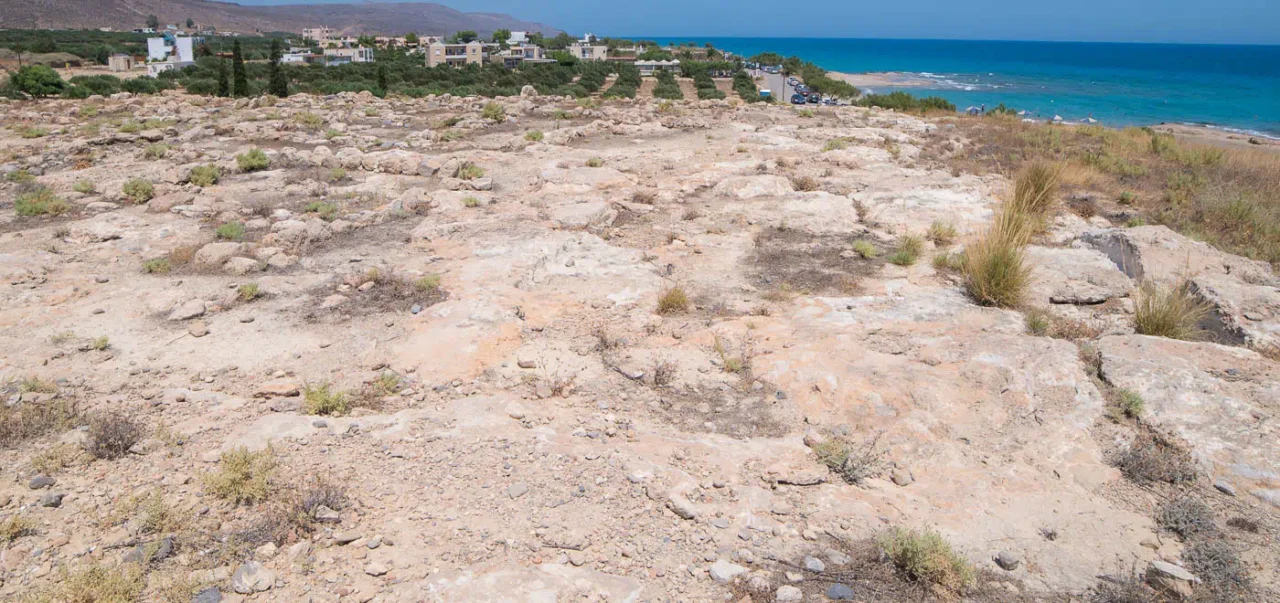
A Coastal Polis with a Dual Urban Center
Ampelos, an ancient city on Crete’s southeastern coast, offers a unique perspective on Hellenistic urban planning and settlement patterns. Unlike many Cretan cities located inland for defensive purposes, Ampelos strategically positioned itself on the coast, indicating a focus on maritime trade and interaction with the broader Mediterranean world.
Strategic Location and Maritime Significance
Ampelos’s coastal location was not merely a defensive choice but a strategic one. The city’s access to the sea facilitated trade and communication with other coastal cities in Crete and beyond. This maritime focus is evident in the city’s layout, which includes two separate urban centers. Ampelos’s engagement in maritime trade likely contributed to its economic prosperity and cultural exchange with other Hellenistic centers.
Dual Urban Centers: A Unique Feature
One of Ampelos’s most distinctive features is its dual urban centers. The city was not confined to a single location but comprised two distinct urban areas functioning concurrently. This arrangement is unusual in the context of ancient urban planning and suggests a complex social and economic organization within the city.
Pharmakokephalo: The Coastal Center
The first urban center, located at Pharmakokephalo, served as the coastal hub of Ampelos. This area likely housed the harbor, commercial districts, and residences of those involved in maritime activities. The coastal center’s proximity to the sea would have facilitated trade, fishing, and other sea-related industries, making it a vital economic zone for the city. Excavations at Pharmakokephalo have revealed a fortified settlement with walls, towers, and various buildings, attesting to its importance as a coastal center. The presence of a defensive wall suggests that the city was aware of potential threats from the sea and took measures to protect its valuable coastal assets.
Kastri: The Inland Acropolis
The second urban center, situated on the hill of Kastri, approximately 1km south west of Pharmakokephalo, served as the inland acropolis of Ampelos. This elevated location provided a natural defensive advantage, protecting the city from potential threats. The acropolis likely housed administrative buildings, temples, and other structures of civic importance. Its strategic position overlooking the coastal center would have allowed for effective control and communication between the two urban areas. While excavations at Kastri have been limited, the presence of architectural remains and artifacts suggests that it was a significant urban center during the Hellenistic period.
Interconnected Urban Centers
The relationship between Pharmakokephalo and Kastri was one of interdependence and complementarity. The coastal center’s economic activities supported the civic and administrative functions of the acropolis, while the acropolis provided security and oversight for the coastal center. This interconnectedness between the two urban centers reflects a sophisticated urban planning approach that maximized the city’s economic potential while ensuring its safety and stability. The presence of a road or path connecting the two centers would have facilitated the movement of goods, people, and ideas between them, further strengthening their relationship.
Ampelos in the Context of Southeast Crete
Ampelos’s unique urban layout and strategic location place it within the broader context of Hellenistic settlement patterns in southeast Crete. The region was characterized by a network of coastal and inland cities, each with its own economic and political interests. Ampelos’s coastal position and maritime focus likely fostered interactions with other coastal cities like Itanos and Hierapytna, while its inland acropolis may have served as a point of contact with inland settlements. The presence of a fortified settlement at Kastri suggests that Ampelos was aware of potential threats from neighboring cities and took measures to protect itself.
Legacy and Archaeological Significance
Ampelos’s dual urban centers and strategic location offer valuable insights into the complex dynamics of Hellenistic urban planning and settlement patterns in Crete. The city’s archaeological remains provide a tangible link to its past, revealing the interconnectedness of its coastal and inland centers. The study of Ampelos contributes to our understanding of the economic, social, and political factors that shaped the development of Hellenistic cities in Crete and the broader Mediterranean region. Ongoing archaeological investigations at both Pharmakokephalo and Kastri continue to shed light on the city’s history, culture, and relationship with other Hellenistic centers.
Archaeological Site: Key Points
- Construction Period: Hellenistic Period (4th-1st centuries BC)
- Location: Xerokampos, southeast Crete
- Dimensions: The fortified settlement at Pharmakokephalo covers an area of approximately 12,000 square meters. The dimensions of Kastri have not been specified in the provided texts.
- Historical Significance: Unique dual urban centers, maritime trade hub, complex social and economic organization
- Current Status: Archaeological site with ongoing research and excavations
References
- Wikipedia (in greek)
- Nadia Coutsinas, Marianna Katifori, Konstantinos Roussos, Athanasios Argyriou, The Settlement Patterns of the Praisos Region (East Crete) from the Classical to the Venetian Periods, as Revealed Through the SettleInEastCrete Program, 2021, Annuario della Scuola Archeologica di Atene e delle Missioni Italiane in Oriente 99.1
- Nadia Coutsinas, The Establishment of the City-States of Eastern Crete from the Archaic to the Roman Period, 2013, CHS Research Bulletin


There are no comments yet.